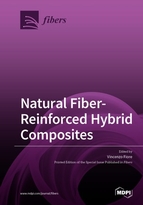Natural Fiber-Reinforced Hybrid Composites
A special issue of Fibers (ISSN 2079-6439).
Deadline for manuscript submissions: closed (15 June 2019) | Viewed by 43899
Special Issue Editor
Interests: natural fibres; polymer composites; biobased materials; hybrid composites; fiber-matrix adhesion; structural joints; mechanical properties
Special Issues, Collections and Topics in MDPI journals
Special Issue Information
Dear Colleagues,
In the last decades, natural fibers have received growing attention as an alternative to the synthetic fibers for the reinforcement of polymeric composites, thanks to their specific properties, low price, health advantages, renewability, and recyclability. Furthermore, natural fibers have a CO2-neutral life cycle, in contrast to their synthetic counterparts.
As widely known, natural fibers possess also some drawbacks, e.g., a hydrophilic nature, low and variable mechanical properties, poor adhesion to polymeric matrices, high susceptibility to moisture absorption, low aging resistance, etc. This implies that their applications are limited to non-structural interior products. To overcome this problem, the hybridization of natural fibers with synthetic ones (i.e., glass, carbon, and basalt) or different natural fibers can be a solution. For this reason, extensive research concerning natural–synthetic and natural–natural hybrid composites has been done in the last years.
The goal of this Special Issue is to gather contributions on the last developments related to the effects of hybridization on the properties of natural fiber-reinforced composites (e.g., mechanical performances, thermal behavior, aging tolerance in humid or aggressive environments, and so on).
I hope that this Special Issue will provide to the scientific community a thorough overview of the current research on the hybridization of natural fibers.
Dr. Vincenzo Fiore
Guest Editor
Manuscript Submission Information
Manuscripts should be submitted online at www.mdpi.com by registering and logging in to this website. Once you are registered, click here to go to the submission form. Manuscripts can be submitted until the deadline. All submissions that pass pre-check are peer-reviewed. Accepted papers will be published continuously in the journal (as soon as accepted) and will be listed together on the special issue website. Research articles, review articles as well as short communications are invited. For planned papers, a title and short abstract (about 100 words) can be sent to the Editorial Office for announcement on this website.
Submitted manuscripts should not have been published previously, nor be under consideration for publication elsewhere (except conference proceedings papers). All manuscripts are thoroughly refereed through a single-blind peer-review process. A guide for authors and other relevant information for submission of manuscripts is available on the Instructions for Authors page. Fibers is an international peer-reviewed open access monthly journal published by MDPI.
Please visit the Instructions for Authors page before submitting a manuscript. The Article Processing Charge (APC) for publication in this open access journal is 2000 CHF (Swiss Francs). Submitted papers should be well formatted and use good English. Authors may use MDPI's English editing service prior to publication or during author revisions.
Keywords
- Natural fibers
- Polymeric composites
- Hybrid composites
- Fiber–matrix adhesion
- Fiber treatments
- Long-term durability
- Water absorption






